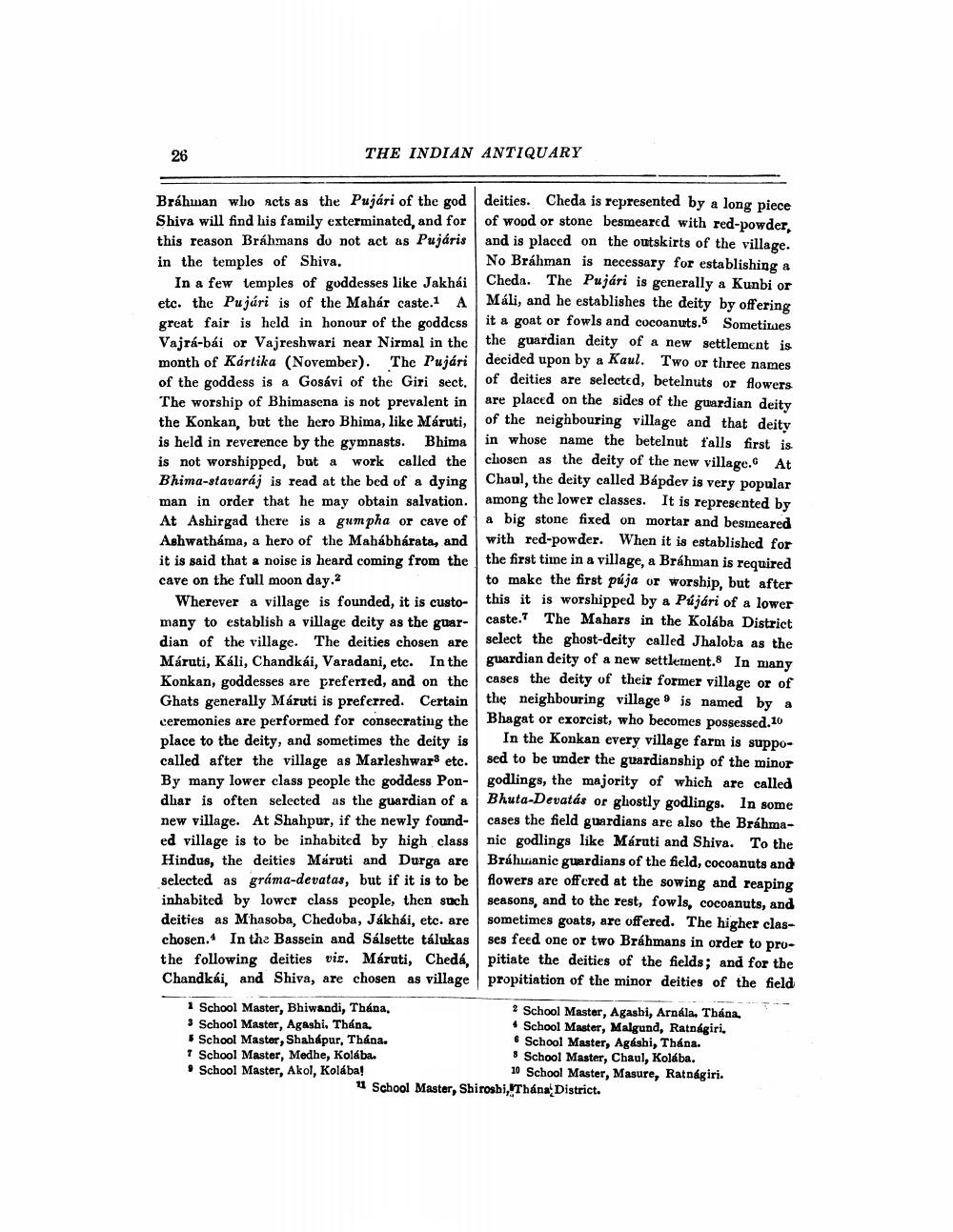________________
26
THE INDIAN ANTIQUARY
Bráhman who acts as the Pujári of the god deities. Cheda is represented by a long piece Shiva will find his family exterminated, and for of wood or stone besmeared with red-powder. this reason Bráhmans do not act as Pujáris and is placed on the outskirts of the village. in the temples of Shiva.
No Bráhman is necessary for establishing a In a few temples of goddesses like Jakhái Cheda. The Pujári is generally a Kunbi or etc. the Pujári is of the Mahár caste.1 A Máli, and he establishes the deity by offering great fair is held in honour of the goddess it a goat or fowls and cocoanuts. Sometimes Vajrá-bái or Vajreshwari near Nirmal in the the guardian deity of a new settlement is month of Kártika (November). The Pujári decided upon by a Kaul. Two or three names of the goddess is a Gosávi of the Giri sect. of deities are selected, betelnuts or powers The worship of Bhimasena is not prevalent in
is not prevalent in are placed on the sides of the guardian deity the Konkan, but the hero Bhima, like Máruti, of the neighbouring village and that deity is held in reverence by the gymnasts. Bhima in whose name the betelnut talls first is is not worshipped, but a work called the closen as the deity of the new village. At Bhima-stavaráj is read at the bed of a dying Chaul, the deity called Bápdev is very popular man in order that he may obtain salvation among the lower classes. It is represented by At Ashirgad there is a gum pha or cave of a big stone fixed on mortar and besmeared Ashwatháma, a hero of the Mahábhárata, and with red-powder. When it is established for it is said that a noise is heard coming from the the first time in a village, a Bráhman is required cave on the full moon day.2
to make the first puja or worship, but after Wherever a village is founded, it is custo
this it is worshipped by a Pújári of a lower many to establish a village deity as the guar
caste.7 The Mahars in the Kolába District dian of the village.
se.
The deities chosen are
The deities chosen are select the ghost-deity called Jhaloba as the Maruti, Káli, Chandkái, Varadani, etc. In the
guardian deity of a new settlement. In many Konkan, goddesses are preferred, and on the
the cases the deity of their former village or of Ghats generally Máruti is preferred. Certain the neighbouring village is named by a ceremonies are performed for consecrating the Bhagat or exorcist, who becomes possessed.10 place to the deity, and sometimes the deity is In the Konkan every village farm is suppocalled after the village as Marleshwar3 etc. sed to be under the guardianship of the minor By many lower class people the goddess Pon- godlings, the majority of which are called dhar is often selected as the guardian of a Bhuta-Devatás or ghostly godlings. In some new village. At Shahpur, if the newly found- cases the field guardians are also the Brahmaed village is to be inhabited by high class nic godlings like Márati and Shiva. To the Hindus, the deities Máruti and Durga are Bráhuanic guardians of the field, cocoanuts and selected as gráma-devatas, but if it is to be flowers are offered at the sowing and reaping inhabited by lower class people, then such seasons, and to the rest, fowls, cocoanuts, and deities as Mhasoba, Chedoba, Jákhái, etc. are sometimes goats, are offered. The higher claschosen. In the Bassein and Sálsette tálukas ses feed one or two Bráhmans in order to prothe following deities vis. Máruti, Chedá, pitiate the deities of the fields; and for the Chandkái, and Shiva, are chosen as village propitiation of the minor deities of the field
1 School Master, Bhiwandi, Thána.
? School Master, Agasbi, Arnála. Thána 3 School Master, Agashi, Thána.
School Master, Malgund, Ratnagiri, 5 School Master, Shahápur, Thána.
& School Master, Agáshi, Thána. * School Master, Medhe, Kolába.
& School Master, Chaul, Kolába. . School Master, Akol, Kolába!
10 School Master, Masure, Ratnagiri. 11 School Master, Shiroshi, Thána District.




